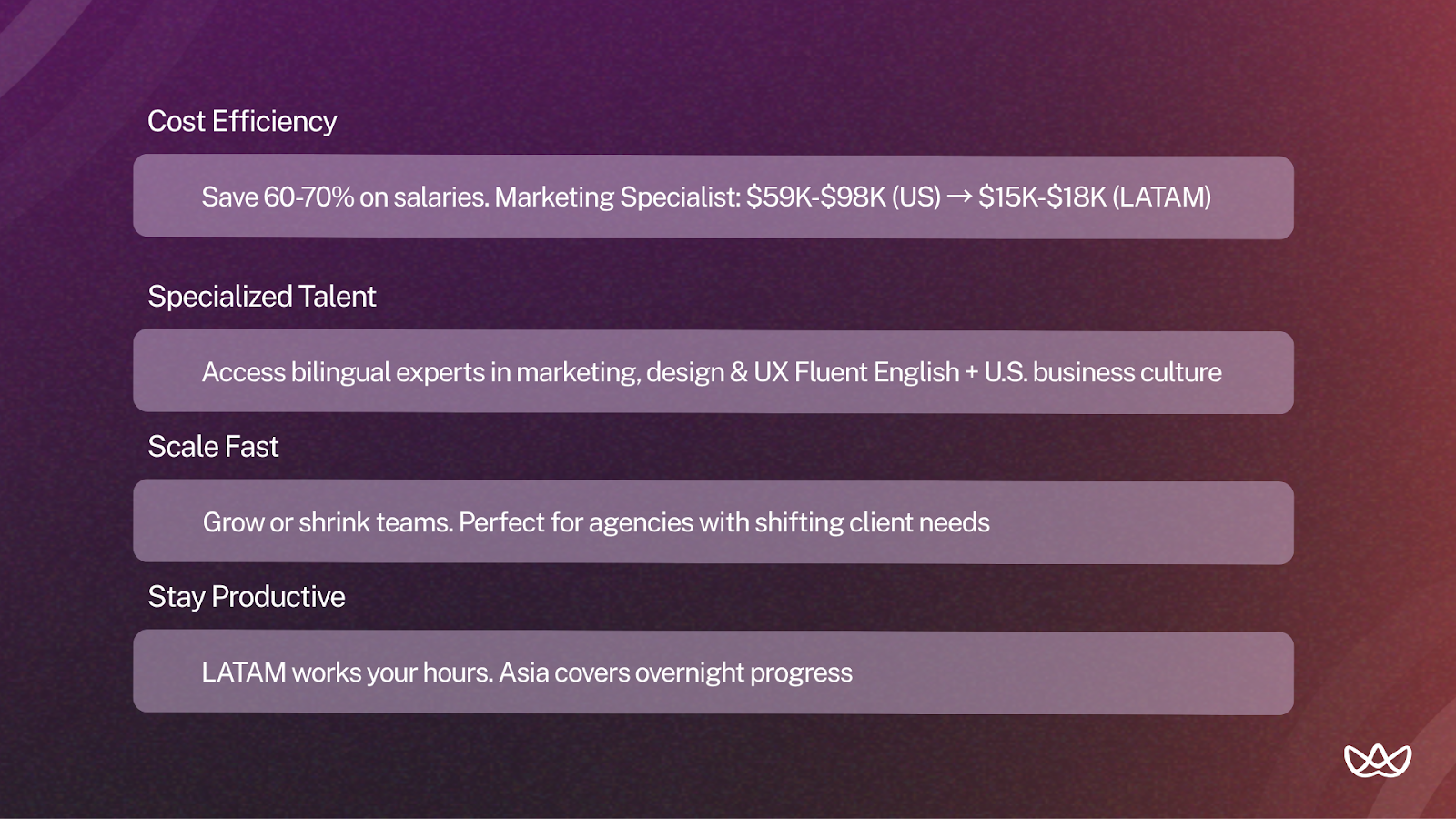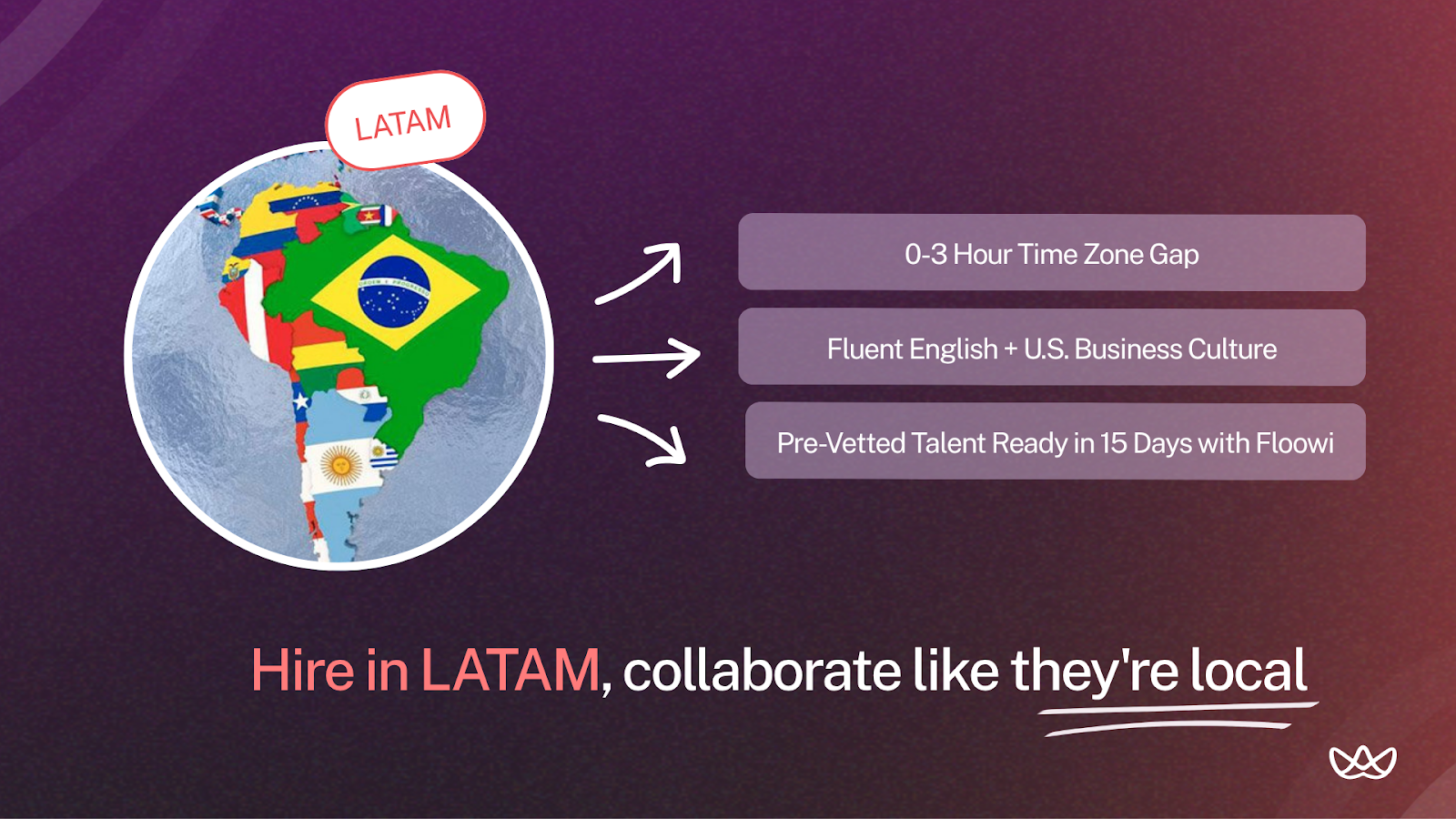Offshore hiring isn’t new, but the way companies use it today has changed. It’s less about cutting costs and more about finding the right skills where they’re available. In 2025, many U.S. businesses rely on offshore teams to close talent gaps, shorten hiring times, and keep operations efficient.
Much of that growth is coming from offshore talent in LATAM. The region offers professionals who work in similar time zones and understand U.S. business communication, which helps teams collaborate more easily.
In this guide, we explain how offshore hiring works today, why it matters, and how you can build and manage teams that fit your company’s goals and compliance needs.
What Does It Mean to Hire Offshore?
Hiring offshore means bringing on talent from countries outside your home base, often to manage costs while accessing skills that are limited or expensive locally. For U.S. companies, this usually involves hiring professionals from regions like Latin America, Asia, or Eastern Europe for roles in marketing, design, content, social media, campaign execution, and other related areas.
The term is often mistaken for other hiring models. Here’s the difference:
Offshore vs. Nearshore vs. Remote Hiring
Latin America is technically nearshore to the U.S., but it’s still part of the offshore ecosystem since employment structures, contracts, and compliance frameworks are international.
That’s why LATAM has become the modern version of offshore hiring - efficient, practical, and aligned with U.S. working hours.
Why U.S. Companies Choose to Hire Offshore Teams

Hiring offshore isn’t only about saving money. Many U.S. companies use it to fill skill gaps, stay flexible, and keep projects moving when local hiring is slow or expensive.
1. Cost Efficiency and Access to Specialized Talent
Hiring offshore helps lower costs while still working with the top talent. A marketing specialist in the U.S. can earn between $59,000 and $98,000 a year. The same job in LATAM often costs about $15,000 to $18,000.
A UX designer who earns around $80,000 in the U.S. might earn close to $10 million COP a year in Colombia. The difference comes from cost of living and currency, not skill level.
You also get access to experts in marketing, design, and content that are harder to find locally. Many LATAM specialists speak fluent English and understand U.S. business culture, which makes collaboration easy from the start.
2. Scalability and Operational Flexibility
Offshore hiring makes it easier to grow or shrink your team when projects change. If you need a few more designers for a campaign, you can bring them on quickly. When the work slows down, you can adjust your team size without major changes to your U.S. staff.
Agencies use this model often. Client needs shift from month to month, and offshore teams let them handle new projects without adding permanent costs.
3. Round-the-Clock Productivity
Offshore teams help keep projects moving outside U.S. hours. LATAM teams usually share the same or close time zones, which makes daily communication simple. Teams in Asia can take over later in the day, so progress continues overnight.
This setup helps meet deadlines and keeps your local team from being overloaded.
4. Focus on Core Growth Functions
Offshore teams usually handle the daily execution work like design, content updates, or campaign setup. That frees your U.S. team to focus on strategy, client management, and business growth.
It’s not about replacing local staff but dividing the work so both sides focus on what they do best.
Best Regions to Hire Offshore Talent in 2025
Asia has led offshore hiring for years, but many U.S. companies now look to LATAM because of time zone closeness and easier communication. Each region has its own use cases depending on what you need.
Latin America: Time Zone Alignment and Bilingual Talent
LATAM professionals work in similar time zones to the U.S., which makes real-time communication easier. A team in Bogotá or Mexico City can join the same meetings as a team in New York or Chicago.

Many professionals speak fluent English and have experience working with U.S. clients. Countries like Colombia, Argentina, and Mexico have strong marketing, design, and operations talent.
Platforms like Floowi connect U.S. companies with pre-vetted LATAM professionals who are bilingual and aligned with U.S. working hours.
Philippines: Customer Support and Admin Operations
The Philippines is well known for customer support and admin roles. English fluency is high, and communication is clear. The time zone gap works well for night shifts or after-hours coverage but limits daytime collaboration.
India: Software and IT Expertise
India has a large pool of developers and IT specialists. The main challenge is the time difference, which makes real-time meetings harder. This setup fits best for handoff-style work where tasks move between time zones.
Eastern Europe: Technical and Creative Skills
Countries like Poland, Ukraine, and Romania offer strong technical and design skills. Many professionals there have experience working with U.S. or Western companies. Costs are higher than Asia or LATAM but lower than U.S. rates.
South Africa: Strong Cultural Compatibility
South Africa shares many cultural similarities with U.S. work environments. English is widely spoken, and time zones allow partial overlap with U.S. mornings. Many companies hire here for sales and support roles.
How to Hire Offshore Step by Step
Here’s a six-step process that most companies use:
1. Define Roles, Skills, and Goals
Decide which roles to move offshore. Tasks that require focus or skills that are hard to find locally work well.
Write down the exact responsibilities, tools, and results expected. A clear scope saves time later.
2. Choose the Right Hiring Model
You can hire in three ways:
- Freelancers for short-term or flexible work.
- Direct hires for full-time positions under your own company.
- Employer of Record - if you want to handle day-to-day work while a third party manages contracts, payroll, and compliance.
Many companies use EORs first to stay compliant without setting up foreign entities.
3. Select the Ideal Offshore Location
Match the region to your needs.
- For real-time collaboration, LATAM aligns with U.S. hours.
- For technical or back-office roles, India or the Philippines offer large talent pools
Check time zone overlap, language skills, and cultural fit before deciding.
4. Vet, Interview, and Test Candidates
Interviews alone don’t show how someone works. Add a small, practical task that matches the role - like drafting a campaign brief for marketing roles or a design sample for creatives.
Check references carefully, and whenever possible, hire through trusted talent networks to avoid long screening cycles.
5. Manage Legal, Payroll, and Compliance
Each country has different employment and tax laws. So, handling these alone is difficult.
An EOR can take care of contracts, payroll, and benefits so your team stays compliant and paid correctly.
6. Onboard, Train, and Integrate Your Team
Give offshore hires the same tools, access, and communication channels as your in-house team. Keep regular check-ins, make expectations clear, and share context about ongoing projects early.
Floowi's model shortens this process to less than 15 days through vetted candidate pools and automated onboarding systems.
Managing Offshore Teams Effectively
Hiring the right people is one part of the process. Managing them well is what keeps teams productive and aligned. The fundamentals of management stay the same, but distance and cultural context need a bit more structure.
Set Clear KPIs and Communication Cadence
Each role needs defined results.
- Marketing teams can track campaign results or lead numbers.
- Designers can track project timelines and revisions.
- Support teams can track response times and customer ratings.
Hold short weekly meetings to stay aligned. Daily written updates through Slack or similar tools keep everyone in sync without long calls.
Use Collaboration and Project Management Tools
The right tools reduce confusion. Slack works for team communication. ClickUp, Asana, or Notion help manage tasks and deadlines. Loom is useful for recording quick walkthroughs or visual feedback.
Simple time-tracking tools like Toggl can help measure workload without hovering over people. Choose what the team already feels comfortable using.
Promote a Culture of Trust and Accountability
People do better when they know what’s expected and are trusted to do their jobs. Avoid constant supervision. Give clear instructions, share context, and review results regularly.
Acknowledge good work and include everyone in team updates. When people working from Medellín or Mexico City feel part of the same team, work moves smoother.
Conduct Regular Performance Reviews
Have short check-ins every few weeks to discuss progress and remove blockers. Do deeper reviews every quarter to talk through results and next steps. Base discussions on work output and reliability, not personal impressions.
Direct and consistent feedback keeps offshore teams aligned and motivated over time.
Offshore Hiring Risks and How to Avoid Them
Offshore hiring has its challenges, but they’re manageable. Keep communication clear, stick to nearby time zones when possible, make sure legal requirements are met, and check your teams carefully.
1. Communication and Time Zone Challenges
Even when people speak the same language, small differences in tone or phrasing can cause confusion. Time zones add another layer. A question sent at the end of your day may not get answered until the next morning.
Choosing teams in LATAM helps because of overlapping hours. For teams farther away, use written updates, short recorded instructions, and clear task notes to keep work moving.
2. Cultural Alignment and Team Integration
People from different regions work in different ways. Some prefer more direction, while others are used to more independence. These differences can affect teamwork if not discussed early.
Explain how your team communicates and makes decisions. Ask offshore teams to share their own preferences too. Mutual understanding helps avoid friction later.
3. Data Security and Compliance Risks
Working with teams abroad means sharing company data. Laws on data protection differ between countries, and weak controls can create problems.
Use secure systems, limit access to sensitive information, and require NDAs. Make sure offshore partners follow security standards that match U.S. expectations.
4. Maintaining Quality and Productivity Standards
Hiring based on price alone often leads to poor results. Without clear expectations, even experienced people may not deliver what you need.
Set clear quality standards and show examples of acceptable work. Review output regularly and give direct feedback. A short trial period helps confirm fit before making long-term commitments.
Legal and Compliance Essentials
1. Contracts, Tax, and Payroll Requirements
When you hire directly, you follow local laws for pay, taxes, and benefits. Every country has its own process, and mistakes lead to fines or back payments. Misclassifying someone who works full-time as a contractor is a common problem.
An Employer of Record (EOR) handles local employment. They take care of payroll, taxes, and compliance while you manage daily work.
2. Data Protection and Intellectual Property
Contracts should clearly state that your company owns any work or materials produced. LATAM countries generally support IP protection, but the level of enforcement differs. Always include clauses on confidentiality and ownership.
You should also know where company data is stored and who has access. Some industries restrict data from leaving certain regions, so confirm that before hiring.
3. Employment Classification and Local Laws
Each setup has different responsibilities. Contractors are flexible but risky if the role looks like full-time work. Direct hires need full compliance with local employment laws. Most companies use an EOR at first to avoid legal setup in other countries.
What to Look For in a Reliable Offshore Agency
Good offshore partners are clear about how they find and vet talent. They explain their screening process, provide straightforward pricing, and use payroll systems that ensure people are paid on time.
Cultural fit is important. The agency should understand how your company works and match candidates accordingly.
Ask for client references and speak with a few to see what working with the agency is really like.
Warning Signs and Common Pitfalls to Avoid
Watch for agencies that:
- Don’t explain compliance or legal details clearly.
- Promise unrealistic hiring timelines.
- Skip proper skill verification.
- Add unexpected fees later.
- Communicate poorly or go silent after sign-up.
- Have no track record or credible client reviews.
Getting Started
Identify the roles you want to hire offshore, such as routine tasks or positions that are hard to fill locally or highly competitive. Choose regions like LATAM where time zones and language align with your team’s schedule.
Use a vetted partner to handle onboarding and compliance so your new team members integrate smoothly.
If you plan to hire offshore, LATAM is the easiest way to get good results without overspending. Hire with Floowi and book your free consultation today.
Frequently Asked Questions
1. When should a company start hiring offshore vs. staying local?
When hiring locally limits scalability or costs exceed budget thresholds. If you can't find needed skills in your market, or if growing your team domestically would strain cash flow, offshore hiring makes sense. Many companies start when they hit 10-15 employees and need to scale specific functions like marketing or customer support.
2. What's the total cost of offshore hiring, including hidden expenses?
Expect total costs to be 60–70% lower than U.S. equivalents, including onboarding and payroll. A graphic designer making $6,200 USD annually might carry $1,500–$2,000 USD in additional costs for benefits and payroll processing. That compares to $50,000–$82,000 USD for an equivalent U.S. hire.
Project managers typically range from $80,000–$138,000 USD annually in the U.S.
4. What's the difference between EOR, PEO, and direct offshore hiring?
EOR handles compliance and payroll while you manage the work directly. PEO shares HR responsibility, acting as a co-employer. Direct hiring means you establish a legal entity in the foreign country and manage everything in-house. Most companies use EOR models for simplicity and compliance.
5. Why choose Latin America over Asia for offshore hiring?
LATAM combines U.S.-aligned hours, bilingual professionals, and 60–70% cost savings. Real-time collaboration becomes possible when your offshore team works during your business hours. A copywriter costing $66,000–$112,000 USD in the U.S. typically costs $11,000–$12,000 USD annually in Bogotá. Cultural alignment also tends to be stronger, reducing friction in communication and work styles.
6. How do I ensure offshore teams maintain quality standards?
Establish KPIs, conduct weekly reviews, and set clear deliverables. Provide detailed briefs, examples of good work, and regular feedback. Use probationary periods to assess fit. Work with pre-vetted talent sources to start with qualified candidates.
7. How do I bridge cultural differences with offshore teams?
Invest in thorough onboarding, create shared team rituals, and maintain consistent feedback loops. Be explicit about communication preferences, work styles, and expectations. Cultural differences become assets when managed well - diverse perspectives improve problem-solving.










.png)
%20in%202025.png)

